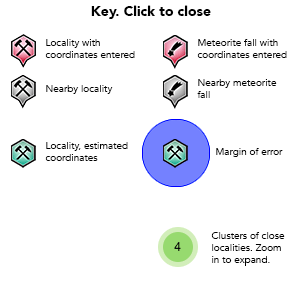Jungle Extension, Snake Mountains District, Elko Co., Nevada, USA

| Latitude & Longitude (WGS84): | 41° 32' 29'' North , 114° 59' 7'' West |
|---|---|
| Latitude & Longitude (decimal): | 41.54161,-114.98530 |
| GeoHash: | G#: 9rqhr6qm2 |
| Köppen climate type: | BSk : Cold semi-arid (steppe) climate |
No description has been added for this locality. Can you add one?
Select Mineral List Type
Standard Detailed Strunz Dana Chemical ElementsCommodity List
This is a list of exploitable or exploited mineral commodities recorded at this locality.No minerals currently recorded for this locality.
Detailed Mineral List:
| ⓘ 'commodity:Barite (Barytes)' Reference: |
List of minerals for each chemical element
Regional Geology
This geological map and associated information on rock units at or nearby to the coordinates given for this locality is based on relatively small scale geological maps provided by various national Geological Surveys. This does not necessarily represent the complete geology at this locality but it gives a background for the region in which it is found.
Click on geological units on the map for more information. Click here to view full-screen map on Macrostrat.org
| Quaternary - Miocene 0 - 23.03 Ma ID: 3185380 | Cenozoic sedimentary rocks Age: Cenozoic (0 - 23.03 Ma) Lithology: Sedimentary rocks Reference: Chorlton, L.B. Generalized geology of the world: bedrock domains and major faults in GIS format: a small-scale world geology map with an extended geological attribute database. doi: 10.4095/223767. Geological Survey of Canada, Open File 5529. [154] |
| Devonian - Furongian 358.9 - 497 Ma ID: 2723128 | Basin Assemblage - Shale, chert, quartzite, greenstone, and limestone Age: Paleozoic (358.9 - 497 Ma) Stratigraphic Name: Valmy Formation; Palmetto Formation; Sonoma Range Formation Description: Includes the Valmy Formation in Eureka, Humboldt, Lander, and Pershing Counties; Devonian to Upper Cambrian mudstone, shale, chert, siltstone, and gray quartzite in Elko County (Leslie, Isaacson, and others, 1991); Devonian to Ordovician slate, chert, limestone, and sandstone in Mineral County; Devonian to Upper Cambrian rocks in Eureka County (Finney, Perry, and others, 1993); some rocks originally mapped as the Palmetto Formation in Esmeralda County (Albers and Stewart, 1972; Ferguson and Cathcart, 1954); and the Sonoma Range Formation (Ferguson, Muller, and Roberts, 1951) in the Sonoma Range in Humboldt County (later included with the Valmy Formation). The distinctions between these rocks and rocks of the Slope assemblage (DOts) are (1) a more complex and varied history of deformation; (2) less well-defined internal stratigraphic characteristics, which may be a function of structural complexity; (3) fewer shale, siltstone, and sandstone interbeds; (4) less carbonate; and (5) in the Roberts Mountains at least, the Ordovician rocks of this unit are older than the Slope assemblage Ordovician rocks. Like unit DOts, no basement is preserved with these rocks, making it difficult to determine where they were originally laid down, and how far they have been transported. This unit includes Devonian, Silurian, Ordovician, and uppermost Cambrian rocks imbricately faulted and folded together. In a few places, Silurian rocks are defined regionally and broken out separately (Ss), but for the most part they are included in this unit. Likewise, significant exposures of Devonian rocks have been included in unit MDst, but many more are not differentiated from this unit. A great variety of depositional settings are present in ocean basins, and this diversity is represented in these rocks (Watkins and Browne, 1989). While these rocks share a common deformation history indicative of east-directed transport from folding and thrusting along regional structures in different areas of Nevada, these rocks have been subject to additional distinct tectonic events during the Mesozoic and the Paleozoic resulting in significant spatial variability in the structure of these rocks (Evans and Theodore, 1978; Oldow, 1984b). Comments: Original map source: Crafford, A.E.J., 2007, Geologic Map of Nevada: U.S. Geological Survey Data Series 249, 1 CD-ROM, 46 p., 1 plate; Scale 1:250,000. Reference: Horton, J.D., C.A. San Juan, and D.B. Stoeser. The State Geologic Map Compilation (SGMC) geodatabase of the conterminous United States. doi: 10.3133/ds1052. U.S. Geological Survey Data Series 1052. [133] |
Data and map coding provided by Macrostrat.org, used under Creative Commons Attribution 4.0 License



